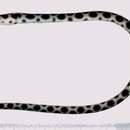Diagnostic Description
provided by Fishbase
Pale cream in color with variable pattern of large and small black spots with narrower white interspaces (Ref. 3972, 48635). Young with black saddles (Ref. 3972). Its behavior is similar to Myrichthys colubrinus and Leiuranus semicinctus.Description: Characterized by head length 12-15 in TL; body depth 33-46 in TL; tail 1.7 in TL; pectoral fin shorter than its base; dorsal fin origin anterior to gill opening; blunt teeth in two rows in jaws (Ref. 90102).
- Recorder
- Cristina V. Garilao
Morphology
provided by Fishbase
Dorsal spines (total): 0; Dorsal soft rays (total): 0; Analspines: 0; Analsoft rays: 0; Vertebrae: 185 - 189
- Recorder
- Cristina V. Garilao
Trophic Strategy
provided by Fishbase
Often in sandy and gravel areas near rocky reefs. Found in sandy areas of reef flats, lagoons, and seaward reefs; living buried in the sand. May aggregate in large numbers under a light at night (Ref. 9710). Sometimes fully exposed when searching for prey (Ref. 30874). A carnivore (Ref. 9137).
- Recorder
- Drina Sta. Iglesia
Biology
provided by Fishbase
Found in sandy areas of reef flats, lagoons, and seaward reefs; living buried in the sand. May aggregate in large numbers under a light at night (Ref. 9710). Sometimes fully exposed when searching for prey (Ref. 30874). Feeds on small fishes and crustaceans (Ref. 89972). Solitary and more common at night (Ref 90102).
Importance
provided by Fishbase
aquarium: commercial
分布
provided by The Fish Database of Taiwan
分布於印度-太平洋之熱帶海域。西起非洲東岸,西至馬歇爾群島,北自日本南部,南迄澳洲。東太平洋分部於加州至祕魯沿岸及島嶼。臺灣主要產於南部海域。
利用
provided by The Fish Database of Taiwan
數量多,具觀賞價值,水族博物館可見。
描述
provided by The Fish Database of Taiwan
全長為頭長的13.4-15.8倍;全長為鰓孔位體高的51.9-58.7倍;全長為軀幹長的2.8-2.9倍;尾長為頭與軀幹之1.4倍;頭長為吻長之4.8倍;吻長為眼徑之1.9倍;胸鰭約為眼徑之1.6倍。尾長大於體長,吻端呈白色且較圓鈍;上頷稍長,口裂超過眼之後緣;無尾鰭,背鰭起點於鰓裂之前,胸鰭較微小,長度不及其基部;肛門在體之前半部,背、臀鰭在近尾端處結束;上、下頜齒及鋤骨齒皆有二列,並且為顆粒狀;前上頷骨齒六枚,與鋤骨齒分離;沿著體側具有三列褐色圓形斑塊,其中的上列與下列為半圓狀,中列則為全圓(接近橢圓狀)且最大,並深入背鰭;眼部周遭則被三至四塊斑紋所包圍。福馬林標本,體有三列咖啡色圓班(中列最大),深入背鰭,臀鰭白色。平均脊椎骨組成:4-77-192,總脊椎骨數為196。豹紋花蛇鰻(/Myrichthys
aki / Tanaka, 1917 )為本種之同種異名。
棲地
provided by The Fish Database of Taiwan
大多棲息於深度約1-260公尺珊瑚礁地區,幼體經常出現於珊瑚礁淺水域,於潮池礁沙混合之處,常可發現其蹤跡。白天一般潛伏於沙地或躲藏於石縫中,夜晚才出外活動覓食。
Myrichthys maculosus
provided by wikipedia EN
Myrichthys maculosus, commonly known as the tiger snake eel,[1] the ocellate snake eel or the spotted snake eel,[2] is a species of fish in the family Ophichthidae, native to the Indo-Pacific. It is occasionally encountered in the aquarium trade. It grows to a length of 1 m (40 in).
Description
An elongated, snake-like fish, Myrichthys maculosus can grow to a length of 1 m (40 in), but a more common size is 50 cm (20 in).[1] The head is small with a short snout and long tubular nostrils pointing downwards. There are two rows of teeth on each jaw and two more rows on the palate. The dorsal fin has its origin just behind the head while the anal fin starts midway along the body; both run to near the tip of the tail. There are no pelvic or caudal fins, and the pectoral fins are small. This fish is cream or yellow, with large, brown or black, circular or oval spots. Young fish have a single longitudinal row of spots while large individuals have three rows.[3]
Distribution and habitat
M. maculosus is found in the tropical and warm temperate Indo-Pacific region. Its range extends from East Africa and the Red Sea to French Polynesia and the Galápagos Islands, and from Japan to eastern Australia. It is not present in Hawaii, where it is replaced by the magnificent snake eel (Myrichthys magnificus). It inhabits lagoons, reef flats, seagrass beds and sandy plains, at depths down to about 260 m (850 ft).[3]
Ecology
This species is mainly nocturnal but can sometimes be seen during the daytime swimming over sandy or vegetated areas.[2] It generally spends the daytime buried in sand, digging itself in tail first. It has a well-developed sense of smell which it uses to locate its prey, which include crustaceans, banded snake eels and other small fish, while they are buried in the sediment.[3] At night, it sometimes aggregates in large numbers at locations where there is artificial lighting. Little is known about the reproduction of this species; the sexes are separate and the larvae are leaf-shaped and known as leptocephali.[3]
References

- license
- cc-by-sa-3.0
- copyright
- Wikipedia authors and editors
Myrichthys maculosus: Brief Summary
provided by wikipedia EN
Myrichthys maculosus, commonly known as the tiger snake eel, the ocellate snake eel or the spotted snake eel, is a species of fish in the family Ophichthidae, native to the Indo-Pacific. It is occasionally encountered in the aquarium trade. It grows to a length of 1 m (40 in).
- license
- cc-by-sa-3.0
- copyright
- Wikipedia authors and editors
Description
provided by World Register of Marine Species
Found in sandy areas of reef flats, lagoons, and seaward reefs, living buried in the sand. Many aggregate in large numbers under a light at night.
Froese, R. & D. Pauly (Editors). (2023). FishBase. World Wide Web electronic publication. version (02/2023).
- license
- cc-by-4.0
- copyright
- WoRMS Editorial Board

